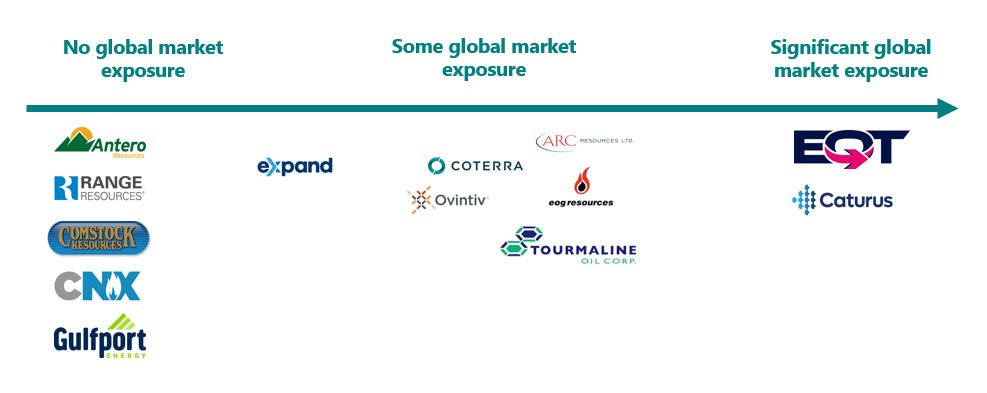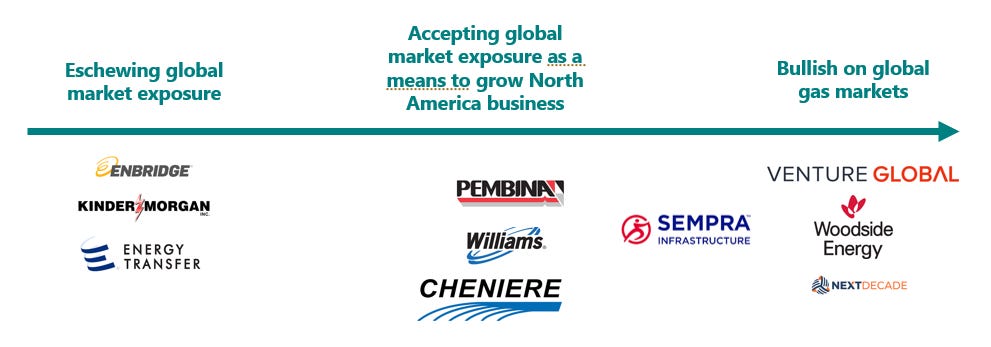The three schools of thought on US LNG
The widening split in how North American operators are approaching the next LNG wave
US LNG FIDs continued apace in the third quarter, despite rising questions about the long-run economics and sky-high stakes for these investments, as we covered last week. But across E&Ps, LNG developers, and portfolio players, companies adopted starkly different postures this earnings season. Broadly, I would characterize the spectrum in three categories:
adding material direct North American LNG investments and/or exposure to global markets
adding some exposure to global markets, either as a complement to or as a means of growing a core North American business
not adding any direct exposure to North American LNG investments or global markets
With that in mind, the following sections assess, by operator type, where different companies sit on that spectrum, and highlight how that divide is emerging across E&Ps, LNG developers, and portfolio players.
E&Ps
Among major North American gas E&Ps, none made a comment as strong as actively eschewing LNG investments, and some without exposure today may eventually add it. For now, though, a handful of North American producers — Coterra, Arc, EOG, Tourmaline, Ovintiv — have contracted for modest LNG capacity or signed netback deals. At the same time, EQT and Caturus stand apart in their aggressiveness in pursuing global gas price exposure. On its earnings call, EQT underscored this view, arguing that global gas price spreads must:
structurally stay wide as long as you do have additional demand growth. … And that’s why we’re so excited about getting into that LNG market even in a small way because even a small increase in that export arb can have meaningful impacts on our profitability and realized pricing.
However, EQT also clarified that its entry into LNG does not stem from bearishness on US prices. This contrasts with Caturus, the Eagle Ford E&P that is also developing the Commonwealth LNG project. Parent company Kimmeridge has taken a more bearish stance on US markets, positing a mid-cycle gas price of $3.50/MMBtu — ~$0.25/MMBtu below the 2028-30 NYMEX strip and ~$0.75/MMBtu below my expectations.
Expand does not yet have any post-FID LNG exposure, as its only SPA is for 0.5 MMtpa from Delfin. It recently announced a long-term gas sales agreement with Lake Charles Methanol, at a premium to NYMEX. Chesapeake signed additional HOAs pre-merger, but so far, Expand appears to see better risk-adjusted returns in selling to LNG buyers than in becoming an LNG player itself. Antero highlighted a different way to benefit from LNG: basis uplift. The company pointed to improved realized prices as Plaquemines ramped up, rallying TGP 500L.
The first wave of US LNG revealed how complex the gas grid is: four of six projects used tolling models, and several new entrants struggled to manage feedgas procurement and pipeline scheduling. E&Ps entering LNG marketing risk repeating those mistakes, although EQT sees LNG marketing as a natural extension of its existing capabilities.
Figure 1 | North American E&P positioning
North American LNG developers
KinderMorgan and Enbridge both emphasized that LNG growth benefits their core fee-based transmission businesses. Even EnergyTransfer, despite its generally more aggressive approach to intrastate transmission development, stressed that LNG is outside its core competency and that it would need to sell down its equity stake before taking FID on Lake Charles.
On the other end of the spectrum, VentureGlobal, Woodside, and NextDecade added global gas exposure this year. Venture Global’s uncontracted liquefaction scenarios imply $5–7/MMBtu global gas price spreads,1 and the company highlighted that at current futures prices, CP2 commissioning cargoes would make $8 billion.
Woodside sanctioned Louisiana LNG with only 1 MMtpa contracted to third parties, highlighting right-skewed global gas price risk, the potential for project delays, and conversations with LNG buyers that give it confidence in marketing its equity offtake. NextDecade argued that LNG demand forecasts lag emerging fundamentals — from renewed interest in gas-fired generation with AI-driven load growth.
Sempra is between schools. The parent company reduced its commodity exposure by selling down its Sempra Infrastructure stake alongside the latter’s Port Arthur Phase 2 FID and concurrent equity sell-down. However, Sempra Infrastructure still holds 5.5 MMtpa at Port Arthur Phase 2. Like Woodside, Sempra expects to sell down this commodity exposure over time, but unlike Woodside, its messaging emphasized portfolio risk reduction rather than a bullish market view.
A third group of developers takes a middle ground, comfortable with some exposure to the global market as a means of growing their core business. While Cheniere has never taken a speculative FID, its positioning appears incrementally more conservative than in prior years. In its earnings call, Cheniere expressed bearishness about global LNG prices and sharply contrasted its contracting approach with its competitors, referring to some of them as “LNG tourists” and highlighting that it sees a:
lack of discipline, [with] projects getting over the FID finish line with a very broad array of counterparties and at times actually no counterparties at all. … So expect things to be very challenging for a number of participants.
Similarly, Pembina sold most of its Cedar LNG offtake to refocus on fee-based earnings.
Williams entered the LNG market through its agreement with Woodside, taking a 10% stake in Louisiana LNG and 1.5 MMtpa of offtake. Williams emphasized that its project equity is supported by take-or-pay contracts,2 that it plans to lay off global price exposure, and that it does not intend to become an LNG marketer, instead using this LNG to serve its producer customers. With the Woodside agreement, Williams also took a majority stake in the Line 200 pipeline that delivers gas to Louisiana LNG. The company sees Line 200 supporting its core business by linking to its gathering and Transco assets.
Figure 2 | North American LNG developer3 positioning
LNG portfolio players
Among portfolio players, Shell remains hesitant: it has not signed new US SPAs since 2022, has called some recent FIDs overly aggressive, and delayed an LNG Canada expansion. Total’s CEO said the US LNG buildout was accelerating too quickly and expressed similar caution about potential oversupply by 2028. However, the company continues to contract selectively for US capacity, including an additional 1.5 MMtpa this year.
At the other end of the spectrum, ConocoPhillips added 5 MMtpa of US LNG this year and signaled appetite for more, based on its confidence in long-term global gas price spreads:
We’re trying to take what we think is low-cost supply in North American gas and get ourselves access to international pricing in TTF and JKM, and that’s exactly what we’re positioning ourselves to do.
Figure 3 | Portfolio player positioning
These three schools of thought ultimately rest on the same three fundamentals described in Part 1: medium-term LNG oversupply, long-run global demand, and long-run Henry Hub prices. After covering the latter last week, the next two pieces in this series examine those first two fundamentals — and explain what would need to happen for each of these schools to be right.
Subscribe at www.measureddepth.com to ensure you receive the next two parts of this series.
After accounting for shipping and regas costs, relative to its $4 and $6/MMBtu capacity fees
Albeit mostly, at this point, with Woodside, implying significant counterparty risk
Although KinderMorgan and Enbridge are not typically thought of as LNG developers, KinderMorgan developed the Elba Liquefaction project, and Enbridge holds an equity interest in Woodfibre. KinderMorgan also owns the Gulf LNG regas terminal, which could eventually be redeveloped into liquefaction.




